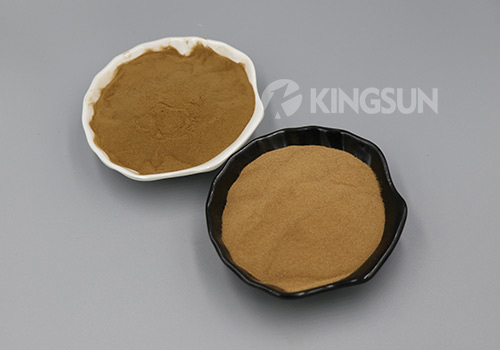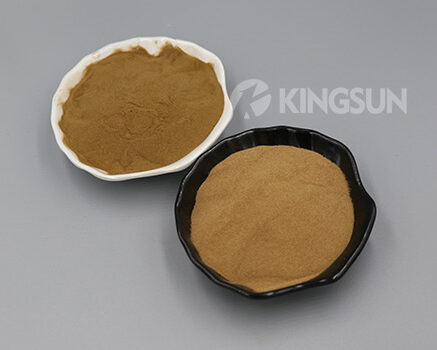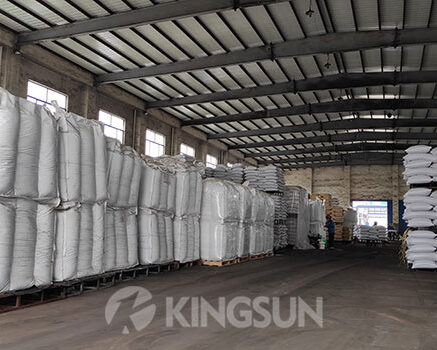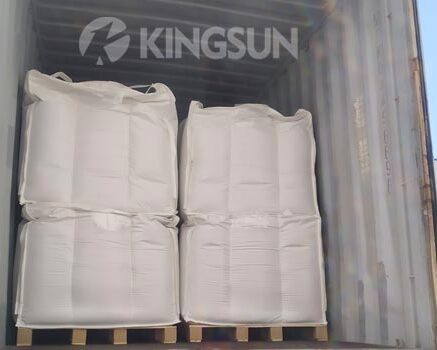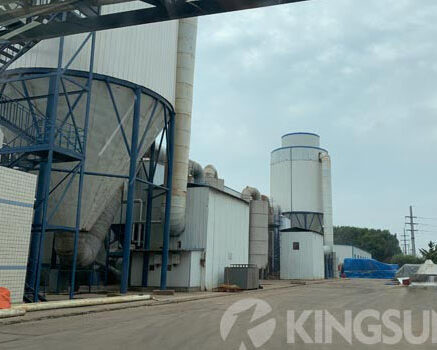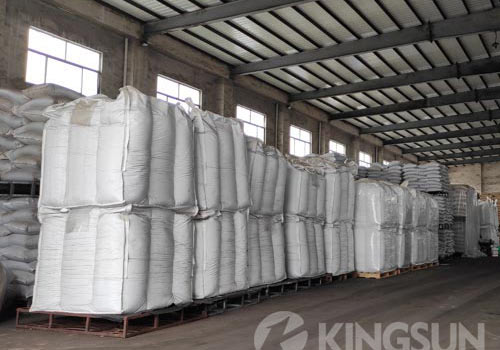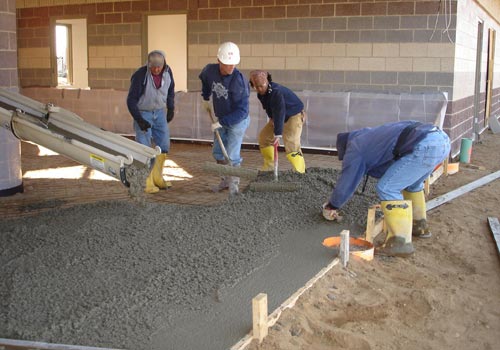Poly Naphthalene Sulfonate (PNS) is also called SNF superplasticizer or naphthalene based superplasticizer or naphthalene sulfonate superplasticizer. Its appearance is light brown powder. As a kind of high efficiency water reducing agent, PNS superplasticizer has the features of high water reduction rate, improved concrete strength, and good dispersion effect on cement, etc. The main use of naphthalene sulfonate is to produce ready-mixed concrete and prepare dry mortar. Especially in the production of flowing concrete, naphthalene superplasticizer not only reduces the water-cement ratio, but also hardens the strength of the concrete material. In addition, polynaphthalene sulfonate can be used as a raw material for many concrete admixtures in the construction industry, such as compound accelerator, antifreeze, retarder, etc.
Poly Naphthalene Sulfonate (PNS) for Concrete
Kingsun poly naphthalene sulfonate superplasticizer can comprehensively improve various properties of concrete, and it can be applied to high compressive strength integral heavy concrete and reinforced concrete, fine concrete, dense cladding concrete, thin plate structure and other complex concrete structures. So naphthalene superplasticizer can be widely used in some construction projects such as highways, bridges, dams, and tunnels, etc.
As a leading manufacturer and supplier of poly naphthalene sulfonate, Kingsun can provide three types of SNF powder for you, they are SNF-A, SNF-B and SNF-C. But if the models are different, then their water reduction rate, price and cost will be different. By the way, please check the technical parameters of PNS superplasticizer in the table below, and choose the right model for your business.
| Type | SNF-A | SNF-B | SNF-C |
| Solid Content (%) ≥ | 92% | ||
| PH Value | 7-9 | ||
| Na2SO4 Content (%)≤ | 5 | 10 | 18 |
| Chlorine Content (%)≤ | 0.3 | 0.4 | 0.5 |
| Net Starch Fluidity(mm)≥ | 250 | 240 | 230 |
| Water Reducing Rate(%) | 26 | 25 | 23 |
| Packing | 25kg pp bag; 650kg Jumbo bag. A customized package is available. | ||
- Product Benefits
- Main Application of PNS Superplasticizer
- Precautions for Use
- Efficient water reduction. The water reduction rate of poly naphthalene sulfonate is as high as 25% or more. Therefore, it not only effectively increases the fluidity of concrete, reduce bleeding and segregation, but also improves the workability of concrete, facilitating construction, and being easy to compact.
- The enhancement effect is good. Under the same conditions of the number of cementitious materials, the compressive strength of concrete with naphthalene superplasticizer has improved compared with the reference concrete.
- Good adaptability. The poly naphthalene sulfonate superplasticizer is suitable for various specifications and models of cement. Therefore, it is easily compatible with other concrete admixtures. For example, the naphthalene based superplasticizer can be used in combination with admixtures such as expansion agents, air-entraining agents, and active agents. And their functions complement and stimulate each other.
- Safety. Naphthalene based superplasticizer is non-toxic, non-irritating, and radioactive, free of substances that are rusting to steel. Non-flammable and explosive, non-dangerous.
- Good durability. Sodium polynaphthalene sulfonate can effectively improve the pore structure of the concrete, thereby greatly improving the durability indexes of concrete such as impermeability, carbonation resistance, and freeze-thaw resistance.
- Large-volume concrete projects, such as large reservoir dams, hydropower station buildings, large equipment foundations, and high-rise building basement slabs, release significant amounts of hydration heat during the hardening process, which can easily lead to significant temperature differences between the inside and outside of the concrete, resulting in thermal cracking. The retarding effect of Polynaphthalene sulfonate superplasticizer can reduce the peak hydration heat and delay the onset of this temperature peak. Furthermore, their water-reducing properties improve the density of the concrete, enhancing its crack resistance and helping to control crack development in large-volume concrete.
- High-strength concrete projects, such as frame columns, shear walls, and beams in high-rise buildings, main beams and piers in long-span bridges, and high-strength prestressed concrete components, require concrete with high compressive strength (typically ≥C50) and good density. The high water-reducing properties of pns superplasticizer can effectively reduce the water-cement ratio, meeting the performance requirements of high-strength concrete.
- Precast concrete component production, such as precast floor slabs, precast beams, precast piles, and concrete blocks. In precast component production, concrete often requires high early strength to shorten mold turnover and improve production efficiency. Naphthalene based superplasticizer can significantly enhance concrete’s early strength while also improving its fluidity, facilitating component forming and vibration, and ensuring the precast component’s visual quality and inherent performance.
- Ready-mixed concrete production. After being produced at a mixing plant, ready-mixed concrete is transported to the construction site by concrete mixer trucks, typically over several to dozens of kilometers, resulting in a lengthy transportation time. The excellent workability retention of poly naphthalene sulfonate reducers effectively reduces slump loss during transportation, ensuring that the concrete maintains good pouring and vibrating properties upon arrival at the construction site, thus meeting the needs of large-scale, long-distance transportation of ready-mixed concrete.
- Summer high-temperature construction or long-distance pouring projects. In hot summer conditions, concrete evaporates rapidly, resulting in significant slump loss and increasing construction complexity. The retarding and slump-retaining properties of naphthalene-based water reducers effectively slow the setting rate of concrete, reducing slump loss caused by evaporation and ensuring smooth construction even under high-temperature conditions. In addition, for long-distance pouring concrete projects (such as cast-in-place box girders for roads and railways), naphthalene sulfonate superplasticizer can also ensure that the concrete still has good workability after long-term transportation.
- Raw material control. The performance of naphthalene sulfonate Superplasticizer is affected by the quality of its raw materials and production process. Therefore, when choosing a water reducer, priority should be given to products produced by regular manufacturers, and their factory inspection reports and certificates of conformity should be checked. During use, the raw materials should also be regularly sampled and quality controlled to ensure that the quality of the raw materials is stable and reliable.
- Stir evenly. To ensure that naphthalene based superplasticizer is evenly distributed in the concrete, the mixing process must be sufficient and uniform. During the mixing process, the water reducer should first be dissolved in water (such as by solution method), and then added to the mixer along with the mixing water. The mixing time should be appropriately extended to ensure that the water reducer is fully mixed with cement, aggregate and other materials. For dry mixing, the water reducer powder should also be evenly sprinkled into the mixer at the beginning of mixing to avoid local excess or deficiency.
- Dosage control. The dosage of poly naphthalene sulfonate directly affects the performance of concrete. Therefore, the dosage must be strictly controlled according to the engineering requirements and the concrete design mix ratio. Generally speaking, the dosage is calculated based on the mass of cement. The recommended dosage range should be determined through experiments, taking into account factors such as cement type, concrete strength grade, and construction conditions. Excessive or insufficient dosage may lead to a decrease in concrete performance, so the recommended dosage must be strictly followed.
- Avoid mixing. When using poly naphthalene sulfonate superplasticizer, avoid mixing with other types of concrete admixtures (such as retarders, early strength agents, etc.) unless their compatibility is verified by special tests. Chemical reactions or physical effects may occur between different admixtures, resulting in abnormal concrete performance. Therefore, the product instructions and test reports should be carefully read before use to ensure that the selected admixtures do not interfere with each other.
- Dosage adjustment. With the change of construction conditions and the adjustment of concrete performance requirements, the dosage of naphthalene superplasticizer may need to be adjusted accordingly. For example, when constructing in high or low temperature environments, the dosage of water reducer may need to be adjusted to adapt to the impact of temperature changes on concrete performance. Therefore, during use, close attention should be paid to the performance changes of concrete, and the dosage of water reducer should be adjusted in time according to actual conditions.
- Compound use. In some cases, in order to obtain better concrete performance or meet specific engineering requirements, it may be necessary to mix PNS superplasticizer with other types of concrete admixtures. When mixing, the compatibility and synergy between the admixtures should be fully considered, and the optimal mixing ratio and usage method should be determined through experiments. At the same time, attention should be paid to controlling the stability and uniformity of the compounded mixture to ensure that the concrete performance meets the design requirements.
- Storage conditions. The storage conditions of this chemical are crucial to its performance stability. It should be stored in a dry, cool, ventilated dedicated warehouse away from fire and heat sources. Avoid direct sunlight and rain to prevent the water reducer from caking or deterioration due to moisture.
Leading Polynaphthalene Sulfonate Manufacturer in China
As one of the most professional concrete admixtures manufacturers in China, Henan Kingsun Chemical Co., Ltd. is a large-scale enterprise integrating R&D, production, sales and service. We have more than 15 years of experience in construction chemicals industry. Our main products are PNS polynaphthalene sulfonate superplasticizer, PCE polycarboxylate superplasticizer, sodium gluconate, calcium lignosulfonate, sodium lignosulfonate and other concrete additives. The following is the reason why you must choose Kingsun company:
- With strong innovation ability, excellent technology and environmental protection concept, Kingsun has strong competitiveness in the field of concrete admixtures.
- Kingsun has its own factory, the advanced production lines, large warehouse, research & quality inspection center and professional sales team.
- All of Kignsun products are well received by many new and old foreign customers. So far, they have been exported to more than 30 countries, including South Korea, Vietnam, Indonesia, Thailand, Singapore, Malaysia, Philippines, Pakistan, Brazil, South Africa, Chile, Australia, Russia, Turkey, Mexico, Nigeria, Jordan, Bahrain, Bangladesh, UAE, Saudi Arabia, India, etc. Most importantly, many of these customers choose to establish a long-term relationship with our company.
- We always provide high-quality products, competitive poly naphthalene sulfonate price and excellent services for all the customers.

